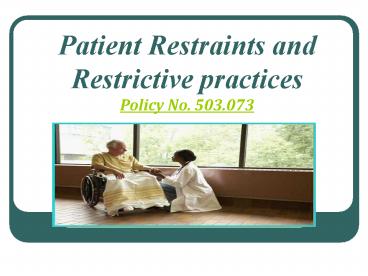Patient Restraints and Restrictive practices Policy No. 503.073 - PowerPoint PPT Presentation
1 / 27
Title:
Patient Restraints and Restrictive practices Policy No. 503.073
Description:
The following are not considered restraints Orthopedic devices Protective helmets ... Arial Arial Black Wingdings Calibri Times New Roman Charter Bd BT ... – PowerPoint PPT presentation
Number of Views:51
Avg rating:3.0/5.0
Title: Patient Restraints and Restrictive practices Policy No. 503.073
1
Patient Restraints and Restrictive
practicesPolicy No. 503.073
2
Philosophy cont.
- The organization seeks to prevent, reduce, and
eliminate the use of restraints or restrictive
practices. Restraints should be used only to
protect the patients health and safety while
preserving the dignity, rights and well-being of
the patient.
3
Alternatives to restraints
- Offer/assist to bathroom or commode
- Diversional activities
- Consider sources of confusion medications,
pain, infection, hypoxia
4
Alternatives to restraints
- Cover tubes
- Relaxation techniques
- Contact physician for further intervention
- Personal alarms/bed alarms
5
Alternatives to restraints
- Reorientation
- Frequent contact
- Move closer to nurses station
- Family/sitter
6
Alternatives to restraints
- Visual reminders
- Reposition or ambulate
- Decrease stimulation
- Obtain a physicians order to remove any
unnecessary tubes
7
Four typesof restraints
- Physical
- Chemical
- Seclusion
- Therapeutic
- Holding/Physical
- redirection
8
Assessment/Reassessment criteria
- All patients will have an assessment performed to
determine safety and protective needs prior to
the application of restraints, including patient
and family as appropriate. - The use of restraints will be frequently
evaluated and discontinued at the earliest
possible time based on the assessment of the
patients condition.
9
Physical
- Any manual method or physical or mechanical
device, material or equipment that immobilizes or
reduces the ability of a patient to freely move
his or her arms, legs, body or head freely.
10
The following are not considered restraints
- Orthopedic devices
- Protective helmets
- Methods that involve the physical holding of a
patient for the purpose of conducting routine
physical exams or tests.
11
The following are not considered restraints
- Using all four side rails for patients in
specialty beds, i.e. stretchers or patients
experiencing involuntary movements, i.e. padded
siderails for seizure activity.
12
The following are not considered restraints
- Forensic and corrective restrictions imposed by
correction authorities. - Age appropriate child care equipment such as
crib rails or swing, stroller and high chair
safety belts.
13
Application of restraining devices
- Secure the limb restraint to the part of the bed
frame that moves up when the head of the bed is
elevated. - Secure the limb restraint with a quick release
knot like the slip knot. - Do not tie in a knot!
14
Safe Application of soft wrist restraints
15
Leather restraints
- If using a locked restraint device verify you
have immediate access to the key.
16
Safe Application of leather restraints
17
Indications for removal of restraints
- When the patient demonstrates a change in the
behavior that was the reason for the initial
application. - If the behavior has decreased so the risk to the
patient and others is no longer present the
restraint may be removed.
18
Chemical
- Any medication that is used as a restriction to
manage the patients behavior or restrict the
patients freedom of movement and is not
standard treatment or dosage for the patients
condition.
19
Seclusion
- The involuntary confinement of a patient alone in
a room or an area where the person is physically
prevented from leaving. - Used in the Emergency Department
20
Therapeutic holding/physical redirection
- The process of holding a patient in a manner that
restricts movement
21
Leadership Notification and Reporting Requirements
- The Department Director or Clinical Coordinator
will be notified of potential need for use of
restraints prior to application except in an
emergency situation - The Department Director or Clinical Coordinator
will evaluate whether additional resources are
required to facilitate discontinuation of
restraints or minimize recurrent episode.
22
Monitoring Reassessment- timeframes
- Maintenance of Therapy/Promotion of Healing- is
monitored every two hours - Violent and Self-Destructive - require an
initial assessment when restraints are initiated
then every 15 minutes thereafter
23
Monitoring and reassessment- requirements
- Signs of physical and psychological distress,
i.e. positional asphyxia, will be recognized and
responded to in accordance with the Rapid
Response policy PCM - 503.200, CPI training and
department specific Violence Control plans.
24
First Aid Interventions
- For minor injuries such as bruises, cuts or
scrapes - Contact the physician for treatment orders.
- Adhere to Skin impairment policy- PCM policy
502.007 - Pressure ulcer prevention - PCM-502.007
25
Monitoring and reassessment- requirements
- General well-being
- Respiratory/Circulatory status
- Need for fluid/food hydration
- Social needs or requests
- Potential for release/ removal
- Vital signs
- Comfort
- Signs of injury associated with restrictive
practice
26
Transportation of restrained patients
- Restraints will be maintained throughout
transport with the appropriate intensity of
observation - When restraints need to be removed for tests or
procedures/treatments, the patient will be
observed during that period restraints
reapplied prior to transport back to the unit - Documentation will continue as appropriate for
the patient type of restrictive practice - Upon returning to the department the restraint
application will be reevaluated
27
Staff Education
- All staff having direct patient contact must
have - Crisis Prevention Intervention training
- First Aid training
- CPR training































